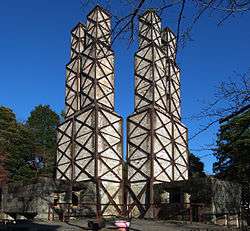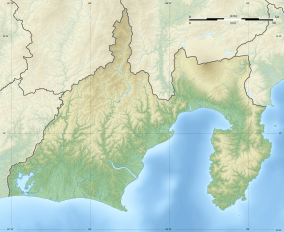Nirayama Reverberatory Furnace
Nirayama Reverberatory Furnaces (韮山反射炉, Nirayama hansharo) are a set of four Edo period reverberatory furnaces erected by the Tokugawa shogunate in what is now the Nirayama neighborhood of the city of Izunokuni, Shizuoka in the Tokai region of Japan. The site was designated a National Historic Site in 1922.[1] and was later designed as part of a World Heritage Site in 2009.[2]
韮山反射炉 | |
 Nirayama Reverberatory Furnaces | |
 Nirayama Reverberatory Furnaces  Nirayama Reverberatory Furnace (Japan) | |
| Location | Izunokuni, Shizuoka, Japan |
|---|---|
| Region | Tokai region |
| Coordinates | 35°02′25″N 138°57′43″E |
| History | |
| Founded | 1852 |
| Abandoned | 1871 |
| Periods | Bakumatsu |
| Site notes | |
| Ownership | National Historic Site |
| Public access | Yes |
Background
During the Bakumatsu period, the Tokugawa shogunate was increasing alarmed by incursions by foreign warships into Japanese territorial waters, fearing that these kurofune warships would attempt the end Japanese self-imposed national isolation policy by force, or would attempt an invasion of Japan by landing hostile military forces. Numerous feudal domains were ordered to establish fortifications along their coastlines with coastal artillery located at strategic locations, and the shogunate made belated attempts to modernize its armed forces.
Egawa Hidetatsu, daikan of the Nirayama Daikansho [3] was assigned a leading role in the reinforcement of Japanese coastal defenses around Edo Bay in 1839.[4] As early as 1842, Egawa attempted to build a furnace to cast cannon in the village of Nirayama in the Izu Peninsula. After sending a student to study the design of a furnace which had been developed in Saga Domain based on Dutch technology, construction began on a new reverberatory furnace in November 1853. It was completed in 1855, and the first cannon cast at the site in 1858. The facility was used until 1864.[5]
In 1868, the Egawa clan purchased the facility from the Tokugawa shogunate and in 1872 it was acquired by Imperial Japanese Army, who performed some repair work in 1908. After it became a National Historic Site in 1922, control was transferred to the Home Ministry with Nirayama municipality assuming responsibility for upkeep since 1957.
Design
The facility consists of four furnaces, each made from refractory bricks, on a stone base, with a height of 15.7 meters. The design of the furnaces was taken from a Dutch book, Het Gietwezen in's Rijks Ijzer - geschutgieterij te Luik, which the Japanese had received via the Dutch trading post at Nagasaki. The southern pair of furnaces were completed in 1855 and the northern pair in 1857.
See also
- List of Historic Sites of Japan (Shizuoka)
- Sites of Japan’s Meiji Industrial Revolution: Iron and Steel, Shipbuilding and Coal Mining
References
- Cullen, Louis M. A history of Japan 1582-1941: internal and external worlds (2003 ed.). Cambridge University Press. ISBN 0-521-52918-2. - Total pages: 357
- Jansen, Marius B.; Whitney Hall, John. The Cambridge History of Japan: The nineteenth century (1989 ed.). Cambridge University Press. ISBN 0-521-22356-3. - Total pages: 886
- Thomas Carlyle Smith. Political change and industrial development in Japan: government enterprise, 1868-1880 (1955 ed.). Stanford University Press. ISBN 0-8047-0469-4. - Total pages: 126
Notes
- "韮山反射炉" (in Japanese). Agency for Cultural Affairs.
- "Sites of Japan's Meiji Industrial Revolution: Iron and Steel, Shipbuilding and Coal Mining". UNESCO. Retrieved 21 October 2015.
- Jansen, Hall 1989, p. 815.
- Cullen 2003, pp. 158-159.
- Smith 1955, p. 6.
External links
| Wikimedia Commons has media related to Nirayama Reverberatory Furnace. |